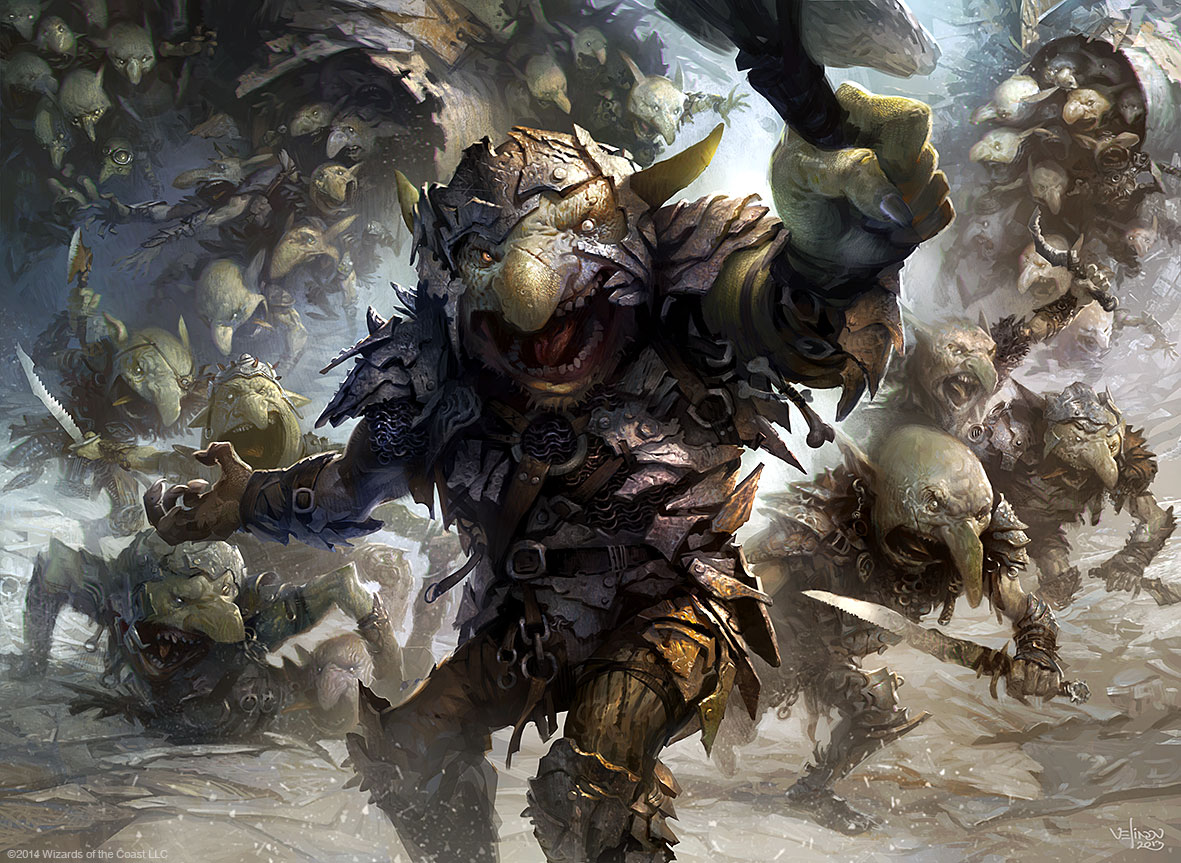One thing that catches up Dungeon Masters old and new is the monster “mob.” We want to recreate that scene in Fellowship of the Ring when the party clashes with dozens of goblins, but we aren’t sure we want to deal with 20-something separate HP totals.
I propose a solution: the hit-point pool.
The basic premise is this: instead of a group of enemies each having separate HP totals, the group has a single HP “pool” that is reduced when the player characters deal damage. This pool abstractly represents the total fighting force of a group of enemies. It requires a lot less bookkeeping (and a lot more common sense).
(Artist credit: Svetlin Velinov)
Wait, How Many Goblins Are There?
Let’s take a scenario and apply this technique.
The player characters are ambushed by a horde of goblins in a dimly lit cavern. “Dozens of green-skinned, yellow-eyed creatures come screaming out of the darkness at you, brandishing crude swords and slinging arrows in your direction,” the DM says. Now instead of writing “Goblin 1, Goblin 2, Goblin 3, etc.” on his sheet of notes, he picks a rough estimate of how many goblins there are (let’s say 20), and totals up their hit points.
In D&D 5E, a basic goblin has 7 HP. So 20 goblins would have an HP pool of 140. If that seems like a lot (or not enough) you can adjust accordingly. Not all monsters are made equal, and these goblins might have more or fewer HP than is typical.
Now the player characters engage with the enemies as normal, but instead of targeting specific enemies (“I attack the goblin directly in front of me,” or “I attack the goblin that just shot me with an arrow”), they simply attack the base AC of the goblins and deal damage directly to the group HP pool. Every 7-or-so damage, you can describe a goblin going down, but you can also be loose in your description, especially if a player character deals enough damage to drop a handful of them in one hit (“You wade through the goblin horde, your steel flashing as you drop several to the floor in bloody heaps”).
When attacking and dealing damage with the horde, simply decide, as a DM, how many enemies would be in range or have line of sight on the heroes, and roll accordingly (you could even roll a D6 and decide to attack the characters with that many goblins).
You can mix up this technique by including a “commander” enemy, who has its own HP and acts independently. Or add multiple groups (“One group of goblins hangs back, taking cover behind some barrels and loosing arrows, while a second group rushes forward brandishing swords and clubs”).
The Benefits of Group HP
This technique works in a similar way to “minions” in D&D 4E, allowing the player characters to chop through waves of enemies, without decreasing the challenge or danger by a significant amount.
It also frees up the DM and makes running combat with lots of enemies easier and more fluid. The pace is quickened, the action is fast and furious, and the tone is one of high adventure.
For the players, it keeps things simpler, and allows them more narrative freedom in how they describe combat. Plus, nothing makes an adventurer feel like more of a badass than hewing through wave after wave of enemy goons.
The Downsides of Group HP
Managing enemies in groups is helpful in a lot of ways, but it requires improvisational skills on the part of the DM. Deciding how many enemies attack each round, how many enemies need to make a saving throw against a spell, how many enemies go down after an attack.
None of these things are covered in the rules of D&D. It really comes down to common sense. Taking a moment to think and visualize the scene, especially without miniatures or a map, will usually tell you everything you need to know. And when in doubt, just make the call (“Four goblins have clear shots with their bows, and are going to loose arrows at you”).
Group HP can also lead to confusion among players who are more rules or numbers-oriented. A player might ask, “Now wait a minute, Sean did 9 damage last round and killed one goblin – I just did 10 and killed two? How does that work?” To these players, I usually say, “Chill out. Why would every goblin have identical HP?” But simply explaining to them that the goblins are attacking as a horde, rather than singular enemies, should nullify any confusion on their part.


I was thinking about testing this out with my group in one of our combats. Seems pretty solid.
1 question though. How would you handle area effect spells such as Burning hands?
Since each creature might only take half damage if they make the saving throw it could get a little muddy….
Would you suggest (if the number of creatures is low enough) rolling each creatures save and working out the total damage, or just hand wave a sort of average damage?